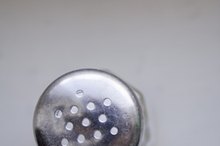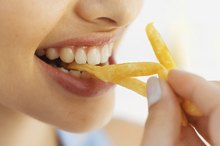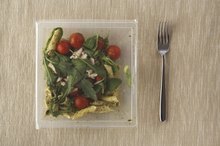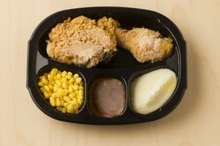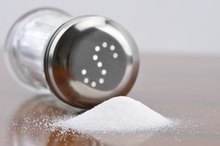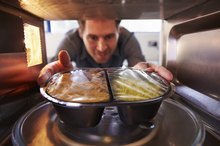Why Are Frozen Foods High in Sodium?
Frozen foods are convenient, relatively inexpensive and possess a fairly long storage life. They provide more variety than canned foods and less preparatory time than creating a meal from scratch. Frozen foods can be risky for those on a low-sodium diet, however, and often contain enough sodium to be considered unhealthy even for those with a regular diet.
Frozen Food Types
Hundreds of frozen dinners are available at supermarkets, ranging from petite low-calorie meals to large, high-calorie dinners. Appetizers and snacks also fit into the frozen food category; these products typically contain meat, cheese, potatoes or breaded vegetables. Frozen pizzas, breakfast foods, vegetables, fruits, meats, poultry, fish, seafood, ice cream and desserts utilize most of the remainder of freezer shelf space in the typical American home.
Reasons for High Sodium Content
What Is the NAS Diet?
Learn More
Processed foods such as frozen dinners, pizza, appetizers and snacks are often high in sodium primarily because the American palate is accustomed to salty foods. Sodium-free meats and combination foods such as pizza are generally not considered tasty and the food industry responds by placing salt where it is expected. Salt is also easier to obtain and cheaper to use than higher-quality flavorings, spices and herbs. Sodium is added as a preservative in some foods.
- Processed foods such as frozen dinners, pizza, appetizers and snacks are often high in sodium primarily because the American palate is accustomed to salty foods.
- Sodium-free meats and combination foods such as pizza are generally not considered tasty and the food industry responds by placing salt where it is expected.
Choosing Frozen Foods
To choose a low-sodium frozen food, first consider fruits and vegetables. Many are prepared without added salt. Seek frozen dinners that have "healthy" on the label or in some other way indicate that they are made with nutrition in mind. You still must check sodium content on the label, as many so-called healthy dinners are fat and calorie-controlled but still contain excessive levels of sodium. According to the University of Maryland Medical Center, healthy Americans should ingest 2,300 milligrams or less of sodium each day while those with high blood pressure or other medical conditions should consume even less. Given this recommendation, you should seek meals that have no more than 500 milligrams of sodium and snacks that have no more than 300 milligrams per serving, unless directed otherwise by your physician.
- To choose a low-sodium frozen food, first consider fruits and vegetables.
- You still must check sodium content on the label, as many so-called healthy dinners are fat and calorie-controlled but still contain excessive levels of sodium.
Making Your Own Frozen Foods
Benefits of Eating Homemade Meals
Learn More
The best way to avoid excessive sodium in frozen food is to make your own meals. Purchase freezer-safe containers and thick bags and prepare single-serving portions of fruits, vegetables, beans, soup and breakfast foods. To make frozen dinners, use divided containers and cook meat or poultry and two vegetables or fruits, allow them to cool, place individual servings in the containers and freeze. You can also make stir-fry bags by grilling chicken or lean steak and adding them to freezer bags with fresh stir-fry veggies such as broccoli, onions, carrots, cabbage, mushrooms and red peppers.
- The best way to avoid excessive sodium in frozen food is to make your own meals.
- To make frozen dinners, use divided containers and cook meat or poultry and two vegetables or fruits, allow them to cool, place individual servings in the containers and freeze.
Related Articles
References
- MSNBC: Should You Defrost Your Diet?
- Ellis E. Frozen Foods: Convenient and Nutritious. Academy of Nutrition and Dietetics. Reviewed January 2020.
- Marcason W. Thawing Frozen Foods. Academy of Nutrition and Dietetics. Reviewed June 2015.
- Freezing and Food Safety. United States Department of Agriculture Food Safety and Inspection Service. Modified June 15, 2013.
Writer Bio
J. Lucy Boyd, RN, BSN has written several nonfiction books including "The Complete Guide to Healthy Cooking and Nutrition for College Students." She is frequently called upon to provide career guidance to medical professionals and advice to parents of children with challenges. She also loves teaching others to cook for their families.
